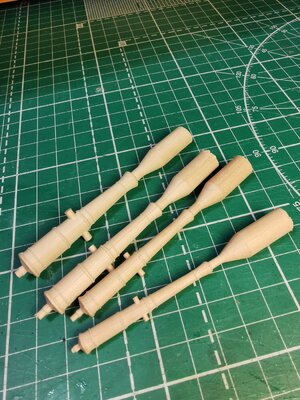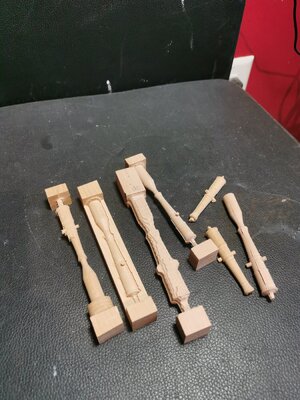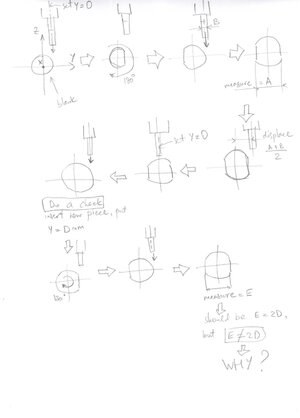Have a great birthday Oleg. Love following your work!
-

Win a Free Custom Engraved Brass Coin!!!
As a way to introduce our brass coins to the community, we will raffle off a free coin during the month of August. Follow link ABOVE for instructions for entering.
-

PRE-ORDER SHIPS IN SCALE TODAY!
The beloved Ships in Scale Magazine is back and charting a new course for 2026!
Discover new skills, new techniques, and new inspirations in every issue.
NOTE THAT OUR FIRST ISSUE WILL BE JAN/FEB 2026
You are using an out of date browser. It may not display this or other websites correctly.
You should upgrade or use an alternative browser.
You should upgrade or use an alternative browser.
Happy Birthday Oleg
Your work on the Royal William is beautiful.
Bill
Your work on the Royal William is beautiful.
Bill
Last edited:
Happy Birthday Oleg 

Happy Birthday, fellow! 

Happy Birthday, Oleg.
I managed to make the 4 guns that I will use for molds. I eventually didn't suceed with the 4th axis. There's something that I don't understand... something is happening and it doesn't work. For some reason I cannot find the 0 of the axes. I go the common way - mill the slot on the side of blank piece, rotate the piece 180deg, mill another slot on the other side of the piece (while it's same bit location). Measure across the flats, divide by 2. If it's Z, lower the Z0 by that amount. If i's Y, add bit radius and mode Y0 by that amount. Should work. But it just dosn't. Had to repeat this operation 3 or 4 times to incrementally arrive to 0. Or more or less 0. But even after that, still doesn't work. Either the peice is deforming, or the bit is deforming, or the 4the axis itself is deplacing or rotating, or I just cannot put the axis straight and align the jaws part with aft fixation, or....
So had to go the usual way, put it on table and manually rotate 180 degrees mid-work. In this way, however, is not possible to completely eliminate the mismatch, if you are lucky, it will be about 0.05-0.1 mm.

And these are unseccessful attempts:

Now need to do some finish at the end, polish, remove the mismatch line and ready for molds.
So had to go the usual way, put it on table and manually rotate 180 degrees mid-work. In this way, however, is not possible to completely eliminate the mismatch, if you are lucky, it will be about 0.05-0.1 mm.

And these are unseccessful attempts:

Now need to do some finish at the end, polish, remove the mismatch line and ready for molds.
Unfortunately something happened to my mill machine. One of the axes is giving loud clanging while moving. Not able to understand if it's coming from the ballscrew or from the 2 sliding guides on the sides... Looks like will have to disassemble it 
- Joined
- Apr 20, 2020
- Messages
- 6,205
- Points
- 738

Happy Birthday OlegI managed to make the 4 guns that I will use for molds. I eventually didn't suceed with the 4th axis. There's something that I don't understand... something is happening and it doesn't work. For some reason I cannot find the 0 of the axes. I go the common way - mill the slot on the side of blank piece, rotate the piece 180deg, mill another slot on the other side of the piece (while it's same bit location). Measure across the flats, divide by 2. If it's Z, lower the Z0 by that amount. If i's Y, add bit radius and mode Y0 by that amount. Should work. But it just dosn't. Had to repeat this operation 3 or 4 times to incrementally arrive to 0. Or more or less 0. But even after that, still doesn't work. Either the peice is deforming, or the bit is deforming, or the 4the axis itself is deplacing or rotating, or I just cannot put the axis straight and align the jaws part with aft fixation, or....
So had to go the usual way, put it on table and manually rotate 180 degrees mid-work. In this way, however, is not possible to completely eliminate the mismatch, if you are lucky, it will be about 0.05-0.1 mm.
View attachment 349649
And these are unseccessful attempts:
View attachment 349650
Now need to do some finish at the end, polish, remove the mismatch line and ready for molds.

the cannons you have made look great, I hope the problem will be fixed soon.
- Joined
- Dec 19, 2022
- Messages
- 72
- Points
- 113

Hi Oleg, happy jam day, be healthy, grow big)
on the 4th axis, Z0 should always be set to the axis of rotation, this is the only way the postprocessor understands this point, if you put it on the surface of the workpiece, it will be weird, and yes, it’s better to mill without trunnions, then embed them, cheap machines cannot work out a high right angle correctly during rotation.
good luck.
on the 4th axis, Z0 should always be set to the axis of rotation, this is the only way the postprocessor understands this point, if you put it on the surface of the workpiece, it will be weird, and yes, it’s better to mill without trunnions, then embed them, cheap machines cannot work out a high right angle correctly during rotation.
good luck.
Last edited:
It would be nice if you get your messages in English, then many of our members would be knowledgeable of your suggestions.Привет Олег, с Днем варенья, будь здоров, расти большой)
на 4-й оси Z0 всегда нужно ставить на ось вращения, только так понимает эту точку постпроцессор, если поставишь на поверхность заготовки, будет чудить, и да, фрезеровать лучше без цапф, потом их врезать, дешевые станки не могут правильно отработать высокий прямой угол при вращения.
удачи.
- Joined
- Dec 19, 2022
- Messages
- 72
- Points
- 113

ок, no problem, сorrectedIt would be nice if you get your messages in English, then many of our members would be knowledgeable of your suggestions.
Thank you!!!ок, no problem, сorrected
Hi Oleg, happy jam day, be healthy, grow big)
on the 4th axis, Z0 should always be set to the axis of rotation, this is the only way the postprocessor understands this point, if you put it on the surface of the workpiece, it will be weird, and yes, it’s better to mill without trunnions, then embed them, cheap machines cannot work out a high right angle correctly during rotation.
good luck.
Yep, of course, Z0 and Y0 should be on the rotation axis, that's what I was trying to do. Here is my problem in pictures: The same was with Z, when I was trying to
set Z0 at the axis. Most probably something is deforming or the whole 4th axis is moving

- Joined
- Dec 19, 2022
- Messages
- 72
- Points
- 113

apparently you didn’t understand, Z0 needs to be set in the center of rotation during tracing, and you are torturing the machine
I can also advise you to check the holding current on the drivers, increase it if possible, but not much, and if you have round guides on the axles, replace them with rail ones, the round ones bend
I can also advise you to check the holding current on the drivers, increase it if possible, but not much, and if you have round guides on the axles, replace them with rail ones, the round ones bend
Last edited:
Да на ось вращения я ее ставлю, и Z и Y. Конечно, это же очевидно. Начало координат должно быть на оси вращения, у меня это X. Я нарисовал в картинках схему нахождения 0 по Y. Эту ось вращения, ее ж найти нужно, чтоб по ней 0 выставить, правильно? По картинкам понятно, в чем моя проблема? 0 по Z пытаюсь находить аналогично, и ту же самую проблему получаю. После того как измерил ширину между двумя отфрезерованными полками, отодвинул фрезу якобы куда нужно, обнулил. Делаю тестовое фрезерование - не выходит. Почему - не знаю. наверное патрон смещается, плохо закреплен на столе. ну или я чего-то не понимаю или как-то неправильно нахожу нули? Причем ошибка по Y выходит раза в два больше, чем по Z. Поэтому приходилось выставлять нули по оси вращения в несколько подходов, в итерационном порядке, что уже бред. Но даже когда выставил, фрезеровка все равно получалась со смещением.
Yes, I put it on the axis of rotation, both Z and Y. Of course, this is obvious. The origin of coordinates should be on the axis of rotation, X in my case. I drew a chematics of finding 0 for Y in the pictures. This axis of rotation, you need to find it in spoace in order to set 0 along it, right? From the pictures it is clear what is my problem? I try to find 0 for Z in a similar way, and I get the similar problem. After I measured across two milled shelves, I moved the spindle supposedly to where I needed it, reset it to zero. Then I do test milling - and it does not work. Why don't know. probably the collet is shifting, maybe poorly fixed on the table. Therefore, it was necessary to set zeros along the rotation axis in several approaches, in iteration order, which is already a nonsense. But even when I set it, milling still turned out with an offset.
Yes, I put it on the axis of rotation, both Z and Y. Of course, this is obvious. The origin of coordinates should be on the axis of rotation, X in my case. I drew a chematics of finding 0 for Y in the pictures. This axis of rotation, you need to find it in spoace in order to set 0 along it, right? From the pictures it is clear what is my problem? I try to find 0 for Z in a similar way, and I get the similar problem. After I measured across two milled shelves, I moved the spindle supposedly to where I needed it, reset it to zero. Then I do test milling - and it does not work. Why don't know. probably the collet is shifting, maybe poorly fixed on the table. Therefore, it was necessary to set zeros along the rotation axis in several approaches, in iteration order, which is already a nonsense. But even when I set it, milling still turned out with an offset.
- Joined
- Dec 19, 2022
- Messages
- 72
- Points
- 113

come to me in WhatsAp, I think we will solve the problem, most likely the axes are not calibrated
Yes, maybe later. First I need to find where is clanging noise coming from and repair the machine. I will post a video next days. Then - find a way of how to fix the 4th axis to the table and how to orient it strictly along Xcome to me in WhatsAp, I think we will solve the problem, most likely the axes are not calibrated
- Joined
- Dec 19, 2022
- Messages
- 72
- Points
- 113

I had a case when the clutch on the stepper motor burst, the machine worked, but gave an error on this axisYes, maybe later. First I need to find where is clanging noise coming from and repair the machine. I will post a video next days. Then - find a way of how to fix the 4th axis to the table and how to orient it strictly along X



